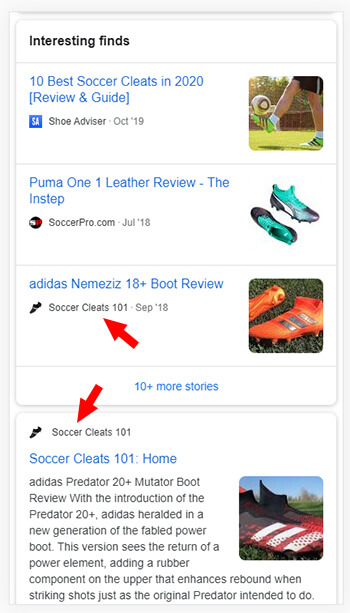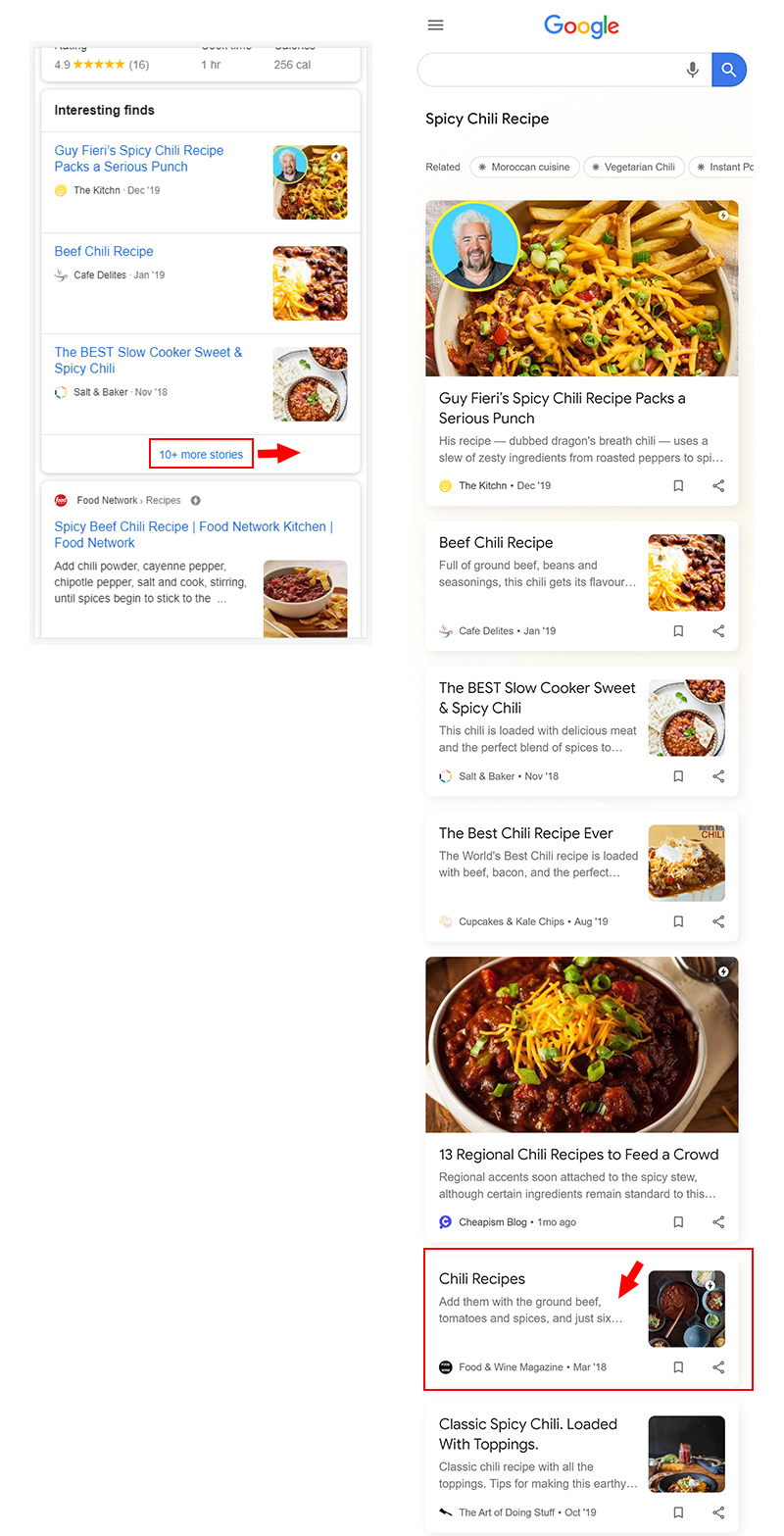Google’s ‘Interesting finds’ SERP feature: The ‘interesting’ reason why mobile organic search traffic remained strong while desktop dropped
The “Interesting finds” module in mobile search results is tough to track, but could be driving a lot of search traffic to your site so use these tips to better understand how it's impacting your site.
While helping a company that dropped during the January 2019 core update, I came across an interesting situation, pun intended. The site dropped by about 30% overall and I began digging into the drop to learn more about what was going on. One thing I noticed pretty quickly was that desktop traffic from Google organic dropped more than mobile, and sometimes much more than mobile for the queries I was checking.
For example, I noticed clicks from Google for some queries dropped 30%+ on desktop, while clicks on mobile-only dropped by 5-10%. I saw this trend a number of times for this specific site. Well, it didn’t take long to see why the drop on mobile wasn’t as bad, and it emphasizes the importance of reviewing SERP features for your own site.
Rankings in the 10-blue links revealed the site did drop several spots for a number of queries on both desktop and mobile, but the drop in traffic was much greater for desktop. So, what happened on mobile that was keeping traffic flowing to the site?
Well, luckily for this site, there was often an “Interesting finds” module in the SERPS where the site ranked well. And for some queries, they ranked multiple times in the “Interesting finds” module! So instead of one organic listing that dropped on page one (and out of the viewport), the site ended up having three listings on page one (and two in an eye-catching SERP feature like “Interesting finds”).
Here is what multiple listings could look like between “Interesting finds” and the 10-blue links. Note, my client is not in this niche. This is just a good example of what it can look like. As you can see below, Planetware.com ranks well in the “Interesting finds” module, which ranks at the top of the SERP. Their listing in the 10-blue links is further down the viewport and below a “People Also Ask” module.

In this post, I’ll explain more about the mysterious “Interesting finds” SERP feature, how it can impact your mobile rankings and traffic, provide examples of the SERP treatment, cover how it’s tracked in GSC, and then end with some final tips. Let’s jump in.
Interesting finds: The untrackable giant organic mobile SERP feature
Last year I wrote a post called 7 Examples of Untrackable Clicks From Google’s Ecosystem, which covered various SERP features that you couldn’t track via GSC reporting (unfortunately). One of those features was “Interesting finds”. While Google now provides tracking for some of the features I listed in that post (like Discover), “Interesting finds” still remains a mysterious, yet powerful, source of untrackable clicks.
For those of you not ultra-familiar with “Interesting finds”, it’s an organic search feature that can show up in the mobile SERPs and provide up to twenty listings in a large module. The first three listings are displayed in the module by default in the SERP and you can click through to see all of the listings on a new page. The module can rank anywhere in the top ten (like most SERP features) and it can even rank number one in some cases. Note, I’ll cover more about tracking and GSC metrics like position, clicks, and impressions later in this post.
Here are some examples of “interesting finds” in action
1. Interesting finds ranking #1 (under Ads):

2. Interesting finds yielding two listings in the top 10:

3. Interesting finds yielding three listings in the top 10:

Hold your enthusiasm, deduping is probably coming to more SERP features
As you can see, “Interesting finds” can take up a lot of real estate, can contain three listings by default on page one, and then enable users to visit a feed-like page with up to twenty listings total. It’s definitely not a SERP feature site owners should ignore.
Also, and as I covered earlier, sites can end up having one or more listings in the module. So if you are already ranking on page one in the 10-blue links, then you could have two, three, or more links technically on page one. For the site I’m helping, the “Interesting finds” module has helped maintain their mobile traffic from Google organic – for now anyway. Read on.
In January, we witnessed some big changes roll out with featured snippets. The biggest change was that Google is now deduping the listing in the 10-blue links when a site receives a featured snippet. For example, a site used to have the featured snippet in the top position with a link to their URL, in addition to a listing in the core search results (linking to the same page). That would yield two links to the same URL on page one of the SERP. With the January change, Google removed the core listing in the 10-blue links and just kept the featured snippet.
Well, the “Interesting finds” module can also duplicate listings yielding multiple links to the same page and to the same site (if the module contained links to other URLs). That’s happening often now and can yield strong traffic to the sites receiving that SERP treatment. But, that’s only if Google keeps the duplicate listings in place moving forward. What if Google decided to dedupe other SERP features beyond featured snippets?
Well, I’m sorry to rain on your “Interesting finds” parade, but Google’s Gary Illyes recently explained that Google is looking at deduping other SERP features beyond featured snippets. And “Interesting finds” could be one of them… That doesn’t mean you can’t have multiple listings on page one (with a core listing and “Interesting finds” listing). but the same URL probably won’t rank in both areas of the SERP. That can definitely impact the exposure of certain sites on page one, and obviously downstream mobile traffic from Google organic.

How “interesting finds” is reported in GSC
OK, I’m sure you are eager to jump into GSC and start reviewing metrics for “Interesting finds” right now. But unfortunately, the search feature falls under “untrackable clicks” from Google’s ecosystem that I mentioned earlier. Metrics are not broken out for “Interesting finds”. Instead, the data will be mixed into your core GSC data. I’ll cover more about the tracking below.
First, I wrote a post on Search Engine Land last year that demystified metrics in GSC. Several of the points I’ll be making below are covered there, so you might want to read that article after this one (or reference it while reading this section).
For position, “Interesting finds” would be considered a “block” in the search results. That means all listings within the module contain the same position. Only three listings are displayed by default, so those are the only three that would gain an impression when an “Interesting finds” module ranks in the default SERP. Listings must be visible in order to gain an impression, so the other listings beyond what’s displayed by default would not gain an impression unless someone clicked through the module to view all of the “Interesting finds” listings.
In addition, for queries, GSC reports on the first link to your site from a position standpoint. So if you had a listing in the 10-blue links that was ranking above “Interesting finds,” then the first listing would be counted for position. But if that listing ranked below the “Interesting finds” module, then the listing in the “Interesting finds” module would count from a position standpoint.
As an example, if you ranked for the query “spicy chili recipe” in the “Interesting finds” block below (in the visible three listings), and then in the 10-blue links below the “Interesting finds” block, then your listing would be reported as position 3 for the query in GSC. That’s the position of the “Interesting finds” block and not the listing in the 10-blue links (which ranks below the “Interesting finds” module).

Now that we covered GSC metrics for the “Interesting finds” module in the default SERP, you might be wondering about the full “Interesting finds” SERP once you tap “10+ more stories”. I’ll cover that next and it’s not as clear…
Tracking in core SERP is clear, but “interesting finds” SERP… not so clear
Again, only the visible listings within an “Interesting finds” module will be counted in the default SERP (which is typically three listings at this time). But if you click through to view all listings in the “Interesting finds” module, there could be an additional 17 listings (or 20 total listings).
And let’s say you ranked sixth in the “Interesting finds” module, you would not receive an impression in the core SERP unless someone tapped “10+ more stories”. That’s because a listing needs to be visible in order to gain an impression. The new “Interesting finds” SERP could display up to 20 listings and your listing would receive an impression once that new SERP was viewed.
Using the “spicy chili recipe” example from before, you can see that Food and Wine Magazine ranks sixth. That listing would not gain an impression until a user viewed the full “Interesting finds” SERP where all 20 listings were visible.

To add a little bit of confusion here, I’m not sure if the listing would receive the position of the module from the core SERP or the new position based on viewing all 20 listings. That’s tough to check given how GSC doesn’t break out “Interesting finds” data in the reporting. I’ll try and find out, though. My guess is that it would be reported as the position of the block in the default SERP. So for this example, the “Interesting finds” block ranks third in the core SERPs, so all the listings would take on that position (even from the full “Interesting finds” page).
Final interesting tips and suggestions
Before I end this post, I wanted to provide some final tips for understanding your “Interesting finds” situation. Again, it could be helping, or saving you, right now in the mobile SERPs:
- First, make sure to review mobile versus desktop traffic changes in Google Search Console (GSC). You can always filter by device to isolate mobile data.
- I recommend analyzing queries that saw a lot of movement traffic-wise and then review the SERPs (both desktop and mobile). Make sure to test those queries via incognito mode within Chrome (and from the right country SERPs if you have international traffic). You can check my tweet to learn how to do that.
- Identify “Interesting finds” modules and how your site fares in the SERPs. See if there are duplicate listings between the 10-blue links and “Interesting finds”. And beyond that, check to see if you have multiple listings within “Interesting finds”, which could yield three or more total listings in the SERPs on page one.
- It’s important to understand that deduping could be coming to “Interesting finds” (for the same URLs showing in the 10-blue links and the “Interesting finds” module.) This probably wouldn’t impact your rankings across different URLs being displayed, but could for the same URL ranking in the 10-blue links and “Interesting finds” module.
- Begin to understand the types of content ranking currently within “Interesting finds” modules for your niche. Then analyze the quality threshold for those topics. Always try to produce killer content to win those spots. Weaker, thinner content will probably not end up in the module. But again, that could vary based on your specific industry. Unfortunately, Google has not provided guidance about “Interesting finds” so you should remain focused on publishing killer content that can hopefully rank in the module.
Summary: Tracking the untrackable
The “Interesting finds” module is a mysterious organic search feature in Google’s mobile search results. It’s a tough module to track, but it’s a dynamic feature that could be driving a lot of search traffic to your site. I recommend following the tips I provided in this post to better understand how “Interesting finds” is impacting your specific situation. One thing is for sure… it’s hard to overlook the feature while using Google on a mobile device. I would work hard to track, and then land, more “Interesting finds” rankings if you can. Good luck.
Contributing authors are invited to create content for Search Engine Land and are chosen for their expertise and contribution to the search community. Our contributors work under the oversight of the editorial staff and contributions are checked for quality and relevance to our readers. Search Engine Land is owned by Semrush. Contributor was not asked to make any direct or indirect mentions of Semrush. The opinions they express are their own.


